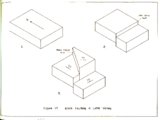| Description |
The Promontory Range, Box Elder County, Utah,, is the first mountain range west of the north-central Wasatch Mountains. An almost complete stratigraphic record from early Late Precambrian to Early Permian is present. No Mesozoic or Tertiary strata have been noted, but the Late Pleistocene is very well represented by the deposits of Lake Bonneville. Systemic lithologies and thicknesses are as follows: Precambrian (phyllite, shale, mafic extrusives, quartzite) 7 44?+ feet; Cambrian (quartzite, calcareous siltstone, limestone, dolomite) 10,762+ feet; Ordovician (limestone, shale, quartzite, dolomite) 2,992+ feet: Silurian (dolomite) 757 feet; Devonian (predominantly dolomite) 1,576""*"" feet; Mississippian (limestone, calcareous orthoquartzite, sandstone, shale) 2,619+feet; Mississippian Pennsylvanian (quartzite, shale) 1,088+ feet; PennsyIvanian-Permian (limestone calcareous orthoquartzite, shale) 3,213+ feet; and Pleistocene (gravel, sand silt, clay) 1,000- feet. The Precambrian and Pleistocene sequences are undifferentiated; 24 Paleozoic formations are recognized but no new formational names are introduced. Three major unconformities have been recognized: (1) at the base of the Upper Ordovician, (2) at the base of the Lower Mississippian, and (3) at the base of the Pleistocene. With the exception of a sill in the Middle Cambrian sequence, igneous rocks are confined to the Precambrian and are largely extrusive. Metamorphism of higher grade than that of the greenschist facies has not been recognized. The Precambrian stratigraphic sequence, carbonate strata in the lower plate of an overthrust fault, and argillaceous Mississippian- Pennsylvanian strata in the northern portion of the range have been subjected to pervasive low-grade metamorphism; but on the whole metamorphism is relatively unimportant in the rocks of the Promontory Range. Structurally the Promontory Range is typical of the mountain ranges of the Basin and Range province. The range is elongate north-south (approximately 30 miles long) and averages six miles wide. A northeast-southwest high-angle fault divides the Promontory Range into northern and southern structural blocks. The characteristic structural features are large fault blocks bounded by high-angle faults. Folding is minor, except in the northern portion of the range. One overthrust fault has been recognized in the west-central portion of the area. It is the oldest structural feature in the Promontory Range. The Laramide orogeny is represented by (1) evidences of overthrusting, presumably from the west, by (2) tight, locally overturned folds which trend approximately north-south, and by (3) minor high-angle reverse faults and major high-angle normal faults. This later faulting has an approximate north-south and east-west pattern and has formed large tilted fault blocks, mostly without strong topographic expression. Gravity surveys indicate that border faults exist below the alluvium along the western and eastern sides of the range, but their topographic expression is not clear. These would belong to the Basin and Range system. |






































































































































































































































































































































































